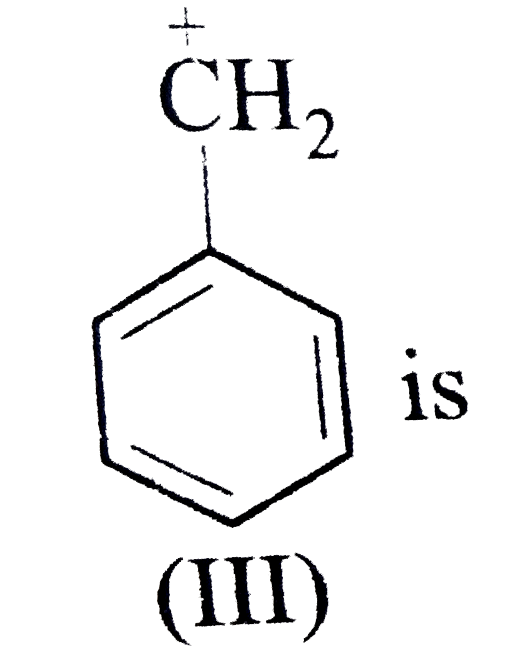Complete Solutions to Bond Fission, Reagents, Reactive Intermediates And Their Stability of chapter SOME BASIC PRINCIPALS OF ORGANIC CHEMISTRY of Class 11 book with complete answers and questions
| Class 11 | CHEMISTRY |
| Chapter | SOME BASIC PRINCIPALS OF ORGANIC CHEMISTRY |
| A2Z | Bond Fission, Reagents, Reactive Intermediates And Their Stability |
| Number Of Questions | 31 |
| Academic Year | 2023-24 |
Which allylic carbocation is most stable?
View SolutionWhat is the increasing order of basic strength of the following compounds in aqueous solution?

View SolutionIn the following compounds,

The order of acidity is:
View SolutionArrange the carbonions,
`(CH_(3))_(3)overset(-)C, overset(-)C Cl_(3), (CH_(3))_(2) overset(-)CH, C_(6)H_(5)overset(-)CH_(2)` in order of their decreasing stability
View SolutionThe most unstable carbocation is:
View SolutionWhich of the following is not an electrophile?
View SolutionMost stable carbonium ion is :
View SolutionThe order of stability of the following carbocations
`underset((I))(CH_(2)=overset(+)(C)H-CH_(2))`, `underset((II))(CH_(3)-CH_(2)-overset(+)(C )H_(2))`

View SolutionThe most stable carbocation is:
View SolutionWrite correct stability order of following compounds.

View SolutionWhich of the following is not a nucleophile?
View SolutionThe stability order of following carbocation is

View SolutionThe electrophile, `E^((o+))` attacks the benzene ring to generate the intermediate `sigma`-complex. Of the following which `sigma`-complex is of lowest energy?
View SolutionThe compound which would give the most stable carbocation on dehydration is :
View SolutionWhich of the following is the rearranged more stable carbocation of the given species?
`CH_(3)-underset(CH_(3))underset(|)overset(CH_(3))overset(|)(C )-overset(o+)(CH)-CH_(3) rarr`
View SolutionWhich of the following is the rearranged more stable carbocation of the given species?

View SolutionWhich of the following is the least stable carbanion?
View SolutionArrange the following carbocation in decreasing order of stability.

View SolutionArrange the following carbocation in decreasing order of stability.

View SolutionAmong the following, the paramagnetic species is:
View SolutionThe increasing order of stability of the following free radicals is:
View SolutionThe hybrid state of positively charged carbon in vinyl `(CH_2 = CH^+ )` cation is :
View SolutionThe stability of given free radicals in decreasing order is
(i) `CH_(3)-overset(.)(C)H_(2)` , (ii) `CH_(3)-Coverset(.)(H)-CH_(3)`
(iii) `CH_(3)-underset(CH_(3))underset(|)overset(.)(C)-CH_(3)`, (iv) `overset(.)(C)H_(3)`
View SolutionWhich of the following is the correct order of stability of free radicals?
View SolutionIn the following carbocations, the stability order is:

View SolutionThe decreasing order of stability of the following cations is
`underset(I)(CH_(3)overset(+)(C)H_(2))`, `underset(II)(H_(2)C=overset(+)(C)H)`, `underset(III)(H-C-=overset(+)(C))`, `underset(IV)(H_(3)C-overset(+)(C)=0)`
View SolutionWhich of the following is most stable carbocation?
View SolutionWhich of the following is most stable carbocation?
View SolutionThe most stable carbocation is:
View SolutionArrange the following carbanions in decreasing order of stability:
`underset((I))(.^(Theta)(CH_(2))-Cl)` , `underset((II))(.^(Theta)(CH_(2))-CN)`, `underset((III))(.^(Theta)(CH_(2))-NO_(2))`, `underset((IV))(.^(Theta)CH_(2)-CH_(3))`
View SolutionGive the stability order of following radicals:
(I) `CH_(3)-overset(*)(C )H_(2)`
(II) `CH_(3)-overset(*)(C )H-CH_(3)`
(III) `CH_(2)=CH-overset(*)(C )H-CH_(3)`
(IV)
View Solution
Bond Fission, Reagents, Reactive Intermediates And Their Stability questions and complete solutions for chapter SOME BASIC PRINCIPALS OF ORGANIC CHEMISTRY of A2Z CHEMISTRY (HINGLISH) of Class 11
All Exercises from A2Z Class 11 CHEMISTRY SOME BASIC PRINCIPALS OF ORGANIC CHEMISTRY
- Acid And Basic Strength
- AIIMS Questions
- AIPMT/ NEET Questions
- Assertion- Reasoning Questions
- Bond Fission, Reagents, Reactive Intermediates And Their Stability
- Confirmational Isomerism
- Geometrical Isomerism
- Inductive, Resonance, Mesomeric And Hyperconjugation
- Optical Isomerism
- Section B - Assertion Reasoning
- Section D - Chapter End Test
- Structure Isomerism
- Tautomerism